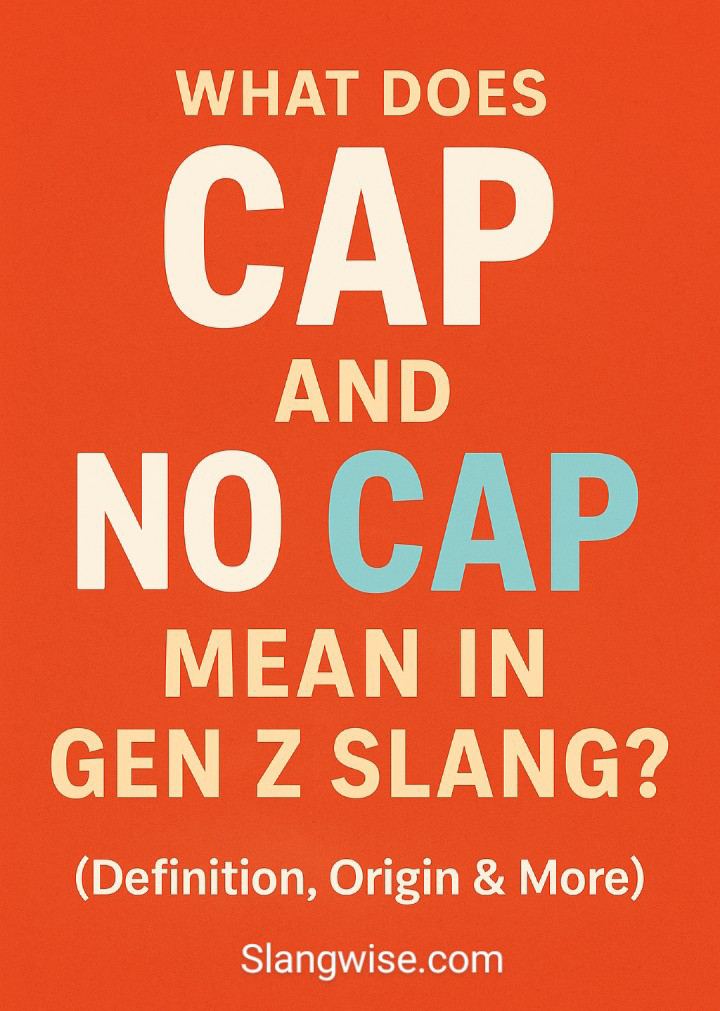Scrolling through social feeds, it’s impossible to miss posts tagged with “cap” or “no cap.”
Far from hats or gaming controls, these terms play a vital role in online conversations, quickly signaling honesty or calling out exaggerations.
In this article, cap and no cap will be unpacked, what they mean, where they come from, and how to deploy them naturally in chats, tweets, or TikTok captions.
When you master these slang words, your conversations stay sharp, authentic, and perfectly in tune with Gen Z’s various slangs.
Table of Contents
In A Nutshell
- Cap = lie or exaggeration: Used to accuse someone of not being truthful.
- No Cap = no lie; for real: Emphasizes sincerity or truthfulness.
- Hip-hop origins: Emerged from Southern rap culture in the 2010s.
- Versatile usage: Fits in texts, social posts, and spoken banter.
- Digital credibility: A well-placed “no cap” builds trust in fast-moving feeds.
Meaning of Cap and No Cap
Cap in Gen Z slang directly means to “lie,” “falsehood,” or “exaggeration.” When someone says “that’s cap,” they’re flat-out calling the statement untrue.
Conversely, No Cap signals “no lie,” “for real,” or “seriously,” stressing that the speaker’s claim is truthful or genuine. Business Insider
Examples:
- “He said he met Beyoncé last night, cap!”
- “I finished my project in one hour, no cap!”
These concise tags instantly frame a statement’s credibility, making cap and no cap indispensable in rapid-fire digital conversations.
Origins of “Cap” and “No Cap”
The slang pair traces back to Southern hip-hop, particularly Atlanta’s rap scene in the early 2010s. Artists like Future, Young Thug, and Lil Baby sprinkled “cap” and “no cap” into lyrics, using it to call out dishonesty or underscore authenticity on tracks.
For instance, Future’s collaborations around 2016 featured lines that juxtaposed truth and lies, cementing the slang in music culture.
According to The New York Times, searches for “no cap” soared by 400% between 2018 and 2020, marking its migration from rap verses into TikTok trends and Twitter threads.
Urban Dictionary’s 2017 entry defines “no cap” as “for real” or “I’m not lying,” reflecting how quickly listeners adopted it as everyday speech.
How to Use “Cap” and “No Cap” in Conversation
Using these tags feels intuitive once the meaning clicks. Below are common ways to use cap and no cap for seamless integration:
Calling Out Exaggerations (Cap)
- Text Chat: “She claimed that coffee shop brews magic, cap!”
- Tweet: “They say the new series is better than Stranger Things, big cap.”
Emphasizing Honesty (No Cap)
- Instagram Caption: “Just landed my dream job, no cap.”
- Verbal Chat: “I honestly can’t believe how good this tastes, no cap!”
Mid-Sentence Usage
- “She aced the exam, no cap, she deserves a medal.”
- “You paid fifty bucks for that hoodie? Cap, right?”
Emoji Pairings
- Cap: 🧢
- No Cap: 🛑🧢 (stop the cap)
Mixing emojis reinforces the punch, perfect for visuals-driven platforms like Instagram and TikTok.
Why “Cap” and “No Cap” Matters These Days
In a Gen Z’s landscape where misinformation and exaggeration abound, cap & no cap equip speakers with tools for instant fact-checking and sincerity-checking. It matters today in:
- Cultural Currency: Using these terms signals cultural fluency and engagement with Gen Z trends.
- Trust Signals: A strategic “no cap” adds credibility, making bold statements easier to believe.
- Concise Clarity: With character limits and rapid scrolls, cap and no cap convey complex ideas in two syllables.
Usage and Examples of Cap and no Cap
Each example below highlights natural placements, whether bragging, calling out, or playfully debating:
- TikTok Caption: “Spent my entire rent money on sneakers, no cap 😅”
- Twitter Thread: “They said the festival was canceled…cap! Got my wristband at the gate.”
- Snapchat Story: “This filter makes me look 10 years younger, cap? No cap.”
Common Mistakes & How to Avoid Them
- Overuse: Sprinkling “no cap” in every sentence dilutes its impact. Reserve it for noteworthy truths.
- Mismatched Tone: Avoid “cap” in formal or professional settings; it fits casual, peer-to-peer banter.
- Lack of Context: Without clear claims, “cap” can confuse listeners. Ensure the target statement is obvious.
Keep it punchy by matching the word to the weight of your statement.
Take Action
- Test Your Slang Savvy: Take the Internet Slang Quiz to see if you can identify more Gen Z terms like “ghosting,” “simp,” and “FOMO.”
- Slang Merch: Visit the Slang-Wear Store for caps and tees that shout “No Cap” and other viral phrases.
Final Thought
In short, “cap” and “no cap” are quick, catchy ways to call out lies or stress that you’re telling the truth. Using them in your texts or posts shows you’re in tune with Gen Z slang and keeps your messages clear and punchy.
Henceforth, call out any “cap,” and drop a confident “no cap” when you really mean it.
FAQs
CAP means “lie,” “falsehood,” or “exaggeration,” used to call out untruths.
No, it works in both written and spoken conversation, from tweets to group chats.
Rarely; sometimes people use it playfully (“That party was cap—so fun!”), but it generally denotes falsehood.
It gained momentum through Southern hip-hop in the 2010s, then exploded on social media platforms like TikTok and Twitter by 2018–2020.

